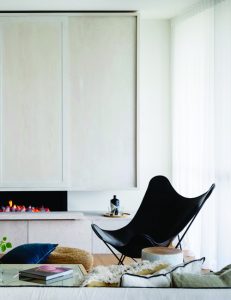Styling for your audience
In a competitive market, the design signature of a project must distinguish it in the minds of potential buyers. If there’s a characteristic that makes Alwill Interiors different, it’s an emphasis on architecture. That’s because founder Romaine Alwill studied interior architecture and her sister is the architect Nadine Alwill, who co-designed the extension to Cate Blanchett’s Hunters Hill home. Romaine finds her inspiration in landscape and architecture, looking outside the four walls to ascertain the essence of a development and bring it within.
“Styling is fundamental
to the success of
the off plan sale”
Romaine has a close relationship with architect Luigi Rosselli and they have worked together on developments including Cascata in Bellevue Hill, and currently on another for the same developer, both of which have achieved noteworthy sales for this blue ribbon area.
Having established Coco Republic Interiors and been interior design editor for Belle magazine, Romaine brings a rare commercial savvy as well as an artisanal aesthetic to her work. Her goal is to work with the architect to embrace the concept they have for the development.
“The design aesthetic should support the “story” of the development, helping to shape a distinct and compelling product that captures the imagination of the buyer demographic.”

“I respond to the site and the concept, really – a beautiful view or a valley it’s overlooking. Because, unlike doing a house for someone, there is no specific client established in a development but rather an audience identified only by rather general characteristics. Thus, the approach needs to be more generic, but there must be a solid concept to respond to.
In the case of Cascata in Double Bay, part of the design journey was deciding on an inspirational name. “It didn’t have one when we came into the project,” Romaine recalls. “Part of the process for us was to develop an aesthetic that supported the name (which became Cascata) to help take a unique and beautiful product to market.”
We recognised the audience was likely to be well-healed downsizers, looking for a luxurious but understated aesthetic. Generally speaking, when it comes to selling off the plan, local trends tend to impact our approach; but our objective
is always to bring a unique flavour to the development.
“For Luigi and myself, Cascata’s solution was about responding to the development’s geography. From the architectural perspective, the building was cascading down a hill. The name Cascata, itself, means ‘cascading’ in Italian. We tried to use natural materials like stone, and it was very light so we had elements of transparency, earthy tones and layered textures in the interior finishes.”

Trends to note
Referring to current trends in materials and palette, Romaine says stone is still popular, but she believes it’s on the wane as more unique finishes, like onyxes and coloured marble take over. Colours include earthy, rusty-reds and sage-greens, paired with dusky pink – creating new neutrals out of colours.
After a visit to the Milan Furniture Fair, Romaine reports that pure forms dominate the industry. Bulkier furniture features more robust detail in the upholstery, with over-locked edges and exposed edges; tactile materials like wicker and leather prevail, oak is still the wood of choice. “People are playing with the structures of things and bringing them out to be the decorated elements, rather than embellishing it outright.”
“Styling for your
locale is critical”
Asked to characterise two very different Sydney suburbs – Bellevue Hill and Surry Hills – Romaine says Bellevue Hill is one of the harder ones to sum up. “It’s not nestled in a context like a beach or the inner city. It’s got a timeless, classic feel because the demographic is generally a bit older.” She finds Surry Hills to be a combination of its lower socio-economic past and its present reinvention as a hip suburb and Sydney’s design centre. “It’s an interesting juxtaposition, like in London, where Holland Park meets Shepherd’s Bush. It crosses a bit of a line.”
 And an ideal furniture choice for each locale? Romaine thinks tables: “In Bellevue Hill you’d have something like a B&B Italia/Maxalto dining table. In Surry Hills it might be something from Jardan or Great Dane.”
And an ideal furniture choice for each locale? Romaine thinks tables: “In Bellevue Hill you’d have something like a B&B Italia/Maxalto dining table. In Surry Hills it might be something from Jardan or Great Dane.”
“People think everyone is the same, that we all like this and we all like that. But actually people are very different and have unique approaches to how they want to live. They have their own stories and styles that they want to bring to the table.
“This is where dual schemes can be very helpful too in engaging potential buyers in a project. It helps them to establish an attachment to the development through their choices – and allows for a variety of tastes.”


